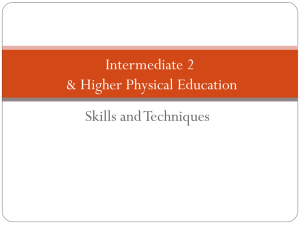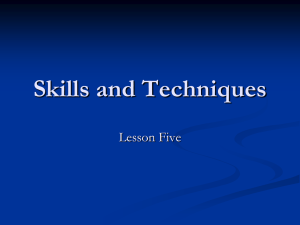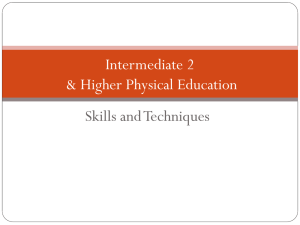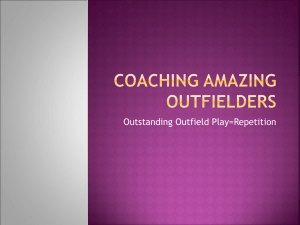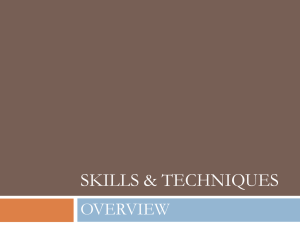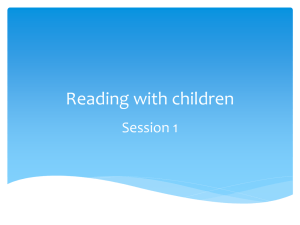lesson_5 - Kirkintilloch High School
advertisement
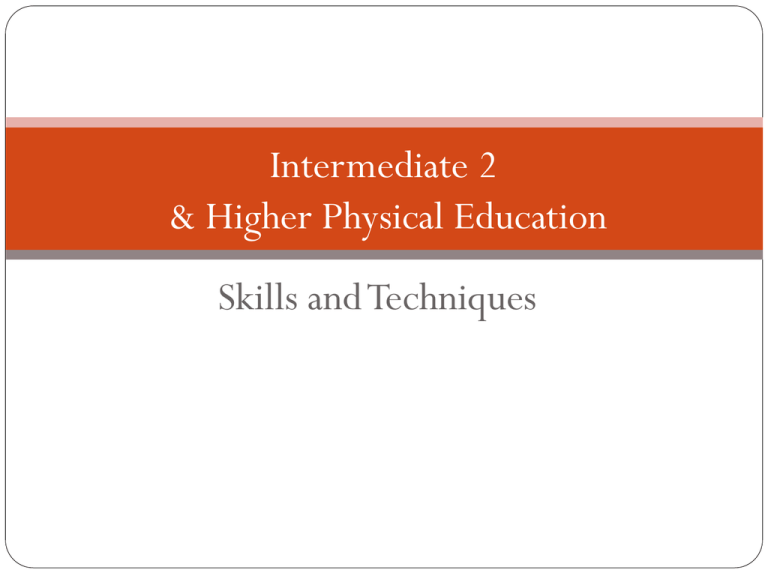
Intermediate 2 & Higher Physical Education Skills and Techniques Lesson objectives… Recap - types / methods of practice Recap - Stages of skill learning Homework feed back – Cognitive stage of skill learning Associative stage of skill learning Peer marking task – describing a weakness in performance Issue homework for Friday 16th December – 1 tasks Recap- Types/methods of practice Click here for last Wednesdays lesson Gradual Build Up Conditioned Stage 5 Games Stage of Skill Learning Gradual Build Pressure StageDrills 4 Up Combination Stage 3 Practice Repetition Stage 2 Practice Shadow Stage Practice 1 Performance Level Methods of practice used on our journey Shadow Practice Cognitive Repetition Practice Associative Combination Practice Pressure Drills Conditioned Games Autonomous Recap-Stages of Skill Learning What are the three stages of skill learning? STAGES OF LEARNING Cognitive Associative Autonomous Cognitive Stage During the planning stage, you find out what the skill involves – work out the subroutines: Preparation Action Recovery At the cognitive stage of skill learning. Limited ability and knowledge of skill. Observing Model performer helps improve knowledge of what it means to perform effectively. Even although some of the subroutines involved in the skill maybe new, it does not mean that you are at the beginner level in badminton. Beginner Level Badminton Player After establishing the different subroutines you make your first attempts at learning the skill using shadow practice. Errors are likely to be common during the planning stage. As a result of this you will need lots of advice and encouragement Homework Feedback Homework feedback Reminder of Homework codes used in PE Excellent of the standard expected Satisfactory, some key content / information missing Unsatisfactory, not of the level required – MUST REDO If you are unsure about Homework come at lunch time or after school and ask! Reminder of homework question Due – Friday 9th December Task 1: Describe what you did at the cognitive stage of skill learning to develop your overhead clear. Give specific performance related examples to support your answer. If you are unsure about Homework come at lunch time or after school and ask! Homework feedback Generally . big improvement, encouragingly there were a number of Some improvements required Use paragraphs - when describing the shadow practice drills you used take a new paragraph for each practice. Common mistakes Not describing the actual shadow practice drills you used. This section of your answer should be like a set of instructions that the reader could use to undertake your practice drills. Not explaining your shadow practice drills fully. • How many overhead clears did you perform? (repetitions) • What was your work to rest ratio? • How many times did you complete each practice (number of sets) Why Shadow Practice is appropriate at Cognitive Stage Shadow practice involves performing the overhead clear in isolation without the distraction of a shuttle. The idea of shadow practice is to grove the skill / increase muscle memory by concentrating on just performing the movement patterns involved in the overhead clear. By removing the shuttle you can focus solely on technique. Shadow practice is an appropriate method of practice during the cognitive stage as it focuses solely on learning the movements involved in the overhead clear. Also errors are common during the planning stage, by removing the distraction of the shuttle I can reduce the number of errors it’s possible to make and remove the need for a feeder. Feedback By removing the need for a feeder I allow my partner to concentrate on providing me with verbal feedback. During the cognitive stage it is important to receive plenty of positive feedback. For the feedback to be effective, it needs to be given as soon as possible. For this reason I had low work to rest ratios during shadow practice drills. During my initial shadow practice drill my partner provided me with feedback after each overhead clear. As my performance improved the feedback was given after 5 overhead clears. It was important that the feedback was positive, giving negative feedback would not have been useful as it would fail to explain how I could improve. Skill Learning - Associative Stage Cognitive Associative Stage of the journey Repetition Practice Associative Combination Practice Pressure Drills Autonomous Associative Stage During the associative stage you link together all the subroutines and practice the skill using a variety of practice methods. Appropriate practice will gradually reduce the number of mistakes made during performance. As performance improves the difficulty of practices will gradually increase. Repetition Drills Combination Drills Pressure Drills Difficulty of practice Performance Level Your level of performance will determine how quickly you progress through the practices. To ensure you move on at the correct time you must have specific success criteria to achieve before you move on. To avoid boredom and ensure high quality practice it is important to vary your practice. If you repeat the same thing over and over again you will become bored, disinterested and your level of performance will decrease. During the associative stage I linked together all the subroutines involved in the overhead clear and practiced the skill by using a variety of different practice methods: 1. Repetition Practice 2. Combination Practice 3. Pressure Drills By completing a varied programme of practice I was able to gradually reduce the number of errors I made when performing the overhead clear. To ensure progression in my practice sessions I increased the difficulty of the practices as my level of performance improved. For example initially I used Repetition Drills which involved my partner feeding the shuttle high above me so I could play an overhead clear. At first I started in the back tramlines but as my performance improved I had to move from base to the rear of the court to return the shuttle. After focussing on repetition practice my level of performance had improved to such an extent that I progressed to using Combination Practices. This involved playing another stroke in addition to my overhead clear. For example initially I worked with two feeders. One fed the shuttle to the rear of the court allowing me to return with an overhead clear, the other dropped the shuttle over the net forcing me to play a net shot before returning to the rear to play another overhead clear. As I was moving towards the automatic stage I started to use Pressure Drills. Initially I used repetition pressure drills which required be to repeatedly perform overhead clears while under pressure. As my performance improved I progressed to using combination pressure drills, which required me to perform my overhead clear along with a net shot in pressured situations. By varying my sessions and having clear progression routes between practice methods I kept my motivation levels up avoiding the onset of boredom. To avoid fatigue I ensured I had adequate rest, my work to rest ration was usually 1:3. When performing I would never have to perform more than 10/15 shots without a break. Repetition Drills Repetition practice involves setting up drills which require you to repeatedly practice a particular part of the overhead clear or the whole technique itself. For example our initial repetition drill involved your partner feeding the shuttle high above you so you could play an overhead clear. At first you started in the back tramlines meaning you didn’t have to move into position (repeatedly practiced the action + recovery phases). As performance improved you had to move from base to the rear of the court to return the shuttle. During repetition practice the intention is to grove the skill. It is vital that movements are performed repeatedly until the movement is grooved into the muscles memory. Work to Rest Ratio In order to groove the skill it is vital that the skill is performed repeatedly, however for practice to be effective you need to consistently perform the skill to a high level. For this reason it is vital to ensure adequate work to rest ratios are used. For example 10 overhead clears would not be enough, but 30 would be to many so you would perform 3 sets of 10. Combination Practice Now you describe combination practice, below is a picture of the games hall white board from Monday. Homework Feedback – Peer Marking Task Reminder of homework question Due – Friday 9th December Task 2: Describe a complex skill which you found to be a weakness. Explain why you considered it to be a weakness. Answer for task 2 should include Intro – aim/objective of overhead clear Explanation as to why OHC is a complex skill Description of overhead clear Comparison of your performance to that of a model performer at the Preparation / Action / Recovery stages. Summary of how this affected the effectiveness of your overhead clear. The overhead clear video used in class may help you with this answer http://www.youtube.com/watch?v=qhe_rRJR9_Y Homework Peer Marking Task Instructions Read your partners answer once. Make a note of the key content required in your partners homework jotter. Key Content Intro – aim/objective of overhead clear Explanation as to why OHC is a complex skill Description of overhead clear Comparison of your performance to that of a model performer at the Preparation / Action / Recovery stages. Summary of how this affected the effectiveness of your overhead clear. Place a , , ? beside each bullet point to indicate if the key content is covered. Read the example answer provided. Compare the answer to your partners work. Provide your partner with written feedback on their homework and colour code it appropriately. Homework feedback (complete as a class after peer marking) Generally Some improvements required Common mistakes Homework Due – Friday 16th December Task 1: Describe in detail three practices you have used for each of the practice methods below. The three practices you describe should gradually increase in difficulty. You may wish to include a simple diagram. • Shadow Practice • Repetition Practice • Combination Practice Task 2 Copy the next slide on Repetition drills into your class jotter and complete the Combination Practice slide. Repetition Drills Repetition practice involves setting up drills which require you to repeatedly practice a particular part of the overhead clear or the whole technique itself. For example our initial repetition drill involved your partner feeding the shuttle high above you so you could play an overhead clear. At first you started in the back tramlines meaning you didn’t have to move into position (repeatedly practiced the action + recovery phases). As performance improved you had to move from base to the rear of the court to return the shuttle. During repetition practice the intention is to grove the skill. It is vital that movements are performed repeatedly until the movement is grooved into the muscles memory. Work to Rest Ratio In order to groove the skill it is vital that the skill is performed repeatedly, however for practice to be effective you need to consistently perform the skill to a high level. For this reason it is vital to ensure adequate work to rest ratios are used. For example 10 overhead clears would not be enough, but 30 would be to many so you would perform 3 sets of 10. Combination Practice Now you describe combination practice, below is a picture of the games hall white board from Monday.
